By Chris Spangler
Adversity breeds resilience, and that is what Jefferson County celebrated Friday as it was emerging from the 16-month-long COVID-19 pandemic.
The Jefferson County Health Department hosted “Commemorating a Small Town’s Resiliency in a Pandemic” at Jefferson County Fair Park.
Department employees, contact tracers and other healthcare workers expressed their gratitude to all who worked so selflessly to help the county weather the coronavirus pandemic, as well as remembered residents whose lives were claimed by this illness.
Altogether, COVID-19 was attributed as the confirmed and probable cause of 113 and 21 county deaths, respectively.
Contact tracer Lindsey Wren welcomed guests, exclaiming, “What a year-and-a-half it has been!
“Do you remember the first time you heard about COVID-19? How many of us had any idea in January of 2020 what the next 18 months would hold?” she asked. “We have been through stay-at-home and masking orders, contact tracing, quarantine, physical distancing, more quarantine, vaccination and, for many individuals, tragedy and feelings of loss, isolation, anxiety and depression.”
She noted that originally, Friday’s gathering was planned as a memorial for area residents lost to COVID-19. However, as the pandemic progressed, organizers saw a need to acknowledge additional elements.
“While we mourn the loss of over 100 people from our community, we also have found silver linings as unexpected as the pandemic itself,” Wren said.
“Though our collective loss is great, it, too, is our strength, our resilience and our partnerships,’ she continued. “Jefferson County has long prized its small-town feel. But there is more to it than farmland or a lack of skyscrapers. We have grit in our bones and innovation runs strong in our blood. Our abilities have found new heights, the depth of our knowledge has become vast, and we’re more resilient than we ever have been.”
Wren said that with spring comes new beginnings.
“Many of us have found a deeper connection to nature over the past year, and I am no exception,” she said. “Recently, I became more aware of cardinals during my nature walks or just sitting in the backyard. Are you aware of the cardinal’s symbolism? I recently learned that if you are lucky enough to spot a cardinal, you should smile. According to superstition, if you should see one, a loved one who has passed away wants you to know that they’re watching over you and you are not alone.”
Given that so many people have felt alone or isolated during this COVID-19 pandemic, Wren said she hopes everyone finds comfort in that thought as she and her co-workers have.
“Because of this, we have used the cardinal as a symbol of our resilience in the painting you see here,” she said, referring to artwork by Robin Chamberlain Sweeney that was commissioned for permanent display at the Jefferson County Health Department lobby and that was formally presented at the end of the program.
Also Friday, public health nurse Keeley Johnson Crosby and county epidemiologist and COVID-19 public information officer Samroz Jakvani together saluted the community.
“We are here today to thank, honor and recognize the people of our community. Those who have fallen to COVID-19, those who fought tirelessly day after day to save lives and protect us and all the others who have been affected by the pandemic, which has defined so much of the last year and a half,” Jakvani said.
In a little more than a year, the United States has lost more than 596,000 individuals, 113 of those deaths recorded in Jefferson County, he noted.
“Many others became severely ill and some continue to experience the effects of the virus months after being infected,” Jakvani said. “Some of us who are here with us right now are still struggling with the effects of the pandemic. We may have lost loved ones, elderly family members and friends, frontline healthcare workers or others we are connected to in some other way.”
Johnson Crosby said that despite these tragedies, the county has been moving in a positive direction in recent months.
“It is a stark contrast from the start of this year, which, as we all experienced, was the peak of COVID cases, of loss, of the worst of the pandemic for us,” she said.
With nearly half of county residents having received the vaccine and coronavirus case rates lower than they have been in a year, the county now is at the opposite end of the pandemic, “fingers crossed,” she added.
Johnson Crosby recalled that in December 2020, the vaccines were improved and shots started going into arms.
“We still have a large number of new cases confirmed every day, especially when compared to any other communicable disease in our county, but we’re nearing what would become the tip of our downward slope now,” she stated.
Jakvani pointed out that at that time, the Jefferson County Health Department began focusing on vaccine clinics, eligibility and “everything that came together to vaccinate thousands of individuals over a short period of time.
“It took something remarkable from the staff that you see here today to roll with the punches and constantly change direction,” he said.
Jakvani shared a quote by Valerie Tuller-laiwa, coordinator of the Latino Task Force in San Francisco, who said: “We don’t panic; we pivot. We are just continually reacting and responding.”
“That sentiment resonates deeply with me, given the past year and everything we have seen,” the epidemiologist said.
“Along with those remorseful elements of loss that we talked about, we are also here to appreciate our unity — our wonderful, resilient community of Jefferson County and all the communities that thrive within,” Johnson Crosby said. “Over the past year, we saw so much change — on an individual level; within our communities; and across the county, state, and country. Along with our physical health, our mental, social and economic wellness has been impacted by the pandemic.”
Jakvani noted that area residents had different experiences during the pandemic depending on their circumstances, occupation and backgrounds.
“Many of us were isolated at home for long periods of time, hesitant to go to the grocery store, or even pick up mail – when we thought that was risky,” he said. “Some of us couldn’t stay home and went to our jobs caring for people, growing their food and teaching their children, even when the world outside our homes was frightening and uncertain.
“While some sick people isolated themselves to a single room for 10 days, others slept in the garage or pitched a tent outside in all types of weather to protect their vulnerable loved ones,” he added. “Many families were quarantined within their home for weeks or months on end in a seemingly endless cycle of exposures and quarantine.”
Johnson Crosby added that many people were not connected with beloved family members and friends like they were used to being.
“We spoke with families whose loved ones were hospitalized, and mourned with them when all they could do was videochat to tell them how loved they were, not knowing whether they’d ever hug them again,” she said.
The isolation and loneliness felt by people, especially the elderly, was so shockingly real, Jakvani agreed.
“I was lucky to have found love shortly before the pandemic and got married during it (in a very safe way), and got a puppy shortly thereafter who still gets me through my tough days,” he shared. “But so many individuals lost their jobs or experienced a significant decrease in their livelihood, or had to take on about as much as they could handle. That impact is still being felt.”
In addition, he pointed out that local businesses have struggled and persevered and then struggled some more. And yet again they persevered, like so many others in the community.
“That is the story we also want to honor today,” Johnson Crosby said. “That of small-town resilience and grit.”
She and Jakvani shared some examples of what they witnessed.
• The husband who waited patiently until his wife was strong enough to FaceTime him from the hospital.
• The family who hosted a drive-through birthday party to give some semblance of normalcy to the best part of being a kid.
• The woman who, when called to get her vaccine, negotiated to get appointments for her entire work family.
• The family who lost someone special — a mom, a wife, a daughter, a healthcare worker – who shared their anguish with us and vowed to honor her memory and sacrifice.
• The nursing home workers who pulled double shifts to cover for sick colleagues.
• The business owners who changed the way they did business, making curbside options available and making their storefronts as safe as possible for the public.
“While it is hard to compare hardships, (I must give) a special acknowledgment of the burden that children and other students have dealt with this past year,” Johnson Crosby said. “From a lack of normal socializing to graduating Zoom University with honors, they have shown us what we are capable of.”
Jakvani also acknowledged school staff “who learned new ways to teach our children.
“You have an impossibly difficult and vital job on any given day, and this past year tested the strength of our school systems as much as it did our healthcare systems,” he said.
Johnson Crosby explained how public health staffers look at Adverse Childhood Experiences, or ACEs, which greatly impact a person’s risk for adverse health status.
“Too much adversity is clearly detrimental, but what we also know is that adversity breeds resilience,” she said. “And it is clear that we are a resilient community, able to overcome the challenges we face and to collectively take our lessons learned forward for mutual benefit.
“What we want to take from this pandemic is an affirmation of our unity, our solidarity with one another and an acknowledgment of our shared vulnerability in the face of a pandemic and other collective threats,” Johnson Crosby continued. “Though many of us are relatively healthy and/or were at low risk of severe illness from COVID-19, we practiced public-health recommendations to stop the spread of COVID-19 and ease the overall burden of the pandemic on our loved ones and our community.”
Jakvani recalled how the community-at-large stepped up to help fight the coronavirus during the past year-plus.
“We stayed at home when case rates were high. We quarantined upon exposure. We wore our masks — mostly,” he said. “We did not do those things just for our own selves. It was to protect all of us. A collective ‘us,’ which especially includes our most vulnerable community members, or our family members. What we sacrificed for others and what we experienced has made us a more resilient people.”
He and Johnson Crosby offered special thanks from the Jefferson County Health Department staff to it leadership and the county board of supervisors, and a “most special thanks to our community members; those who have supported us; those who engaged with us in constructive dialogue; those who wore their masks, distanced from others and stayed home when they were ill; and all the others who fostered their resilience this year.”
Also Friday, Gail Scott, Health Department director and county health officer, observed that 2020-21 has been one of the most trying times for most public health staff, along with many others who are employed in the healthcare field.
“We have seen a record exodus of public health professionals, and many healthcare workers are feeling depleted,” she said. “There is a valid reason for it. Over the past year-and-a-half, we have come together to achieve what would seem impossible.”
Through countless virtual meetings, long hours at night working and thinking about work and the community, and doing the hard work to achieve their objectives, she said, even when information was scarce on this new virus, they found the answers to forge ahead, she stated.
“Whether it was through the Emergency Operations Center, the Testing and Vaccine Task Force, through a different collaboration, or whether you were working on COVID-19-related items outside of those venues, you were our partner,” Scott told attendees.
She called those partners one of the most valuable resources in the county’s coronavirus response.
“Just as testing, vaccination and educational resources were the assets that helped us to achieve our goals, so were the partners and the resulting collective impact,” Scott said. “Simply put, without the help, support and engagement of our partners, our response to the pandemic would have been incomplete, and far less successful than it was.”
She concluded: “So thank you. Thank you for being with us in this effort. Thank you for helping to inspire us. Thank you for helping to keep us going strong in the face of adversity and high case rates and mass misinformation. Thank you for being available for early morning calls and, yes, those last-minute favors. Thank you for helping our community. We know that without true partnerships and collaboration, our work is less impactful. Working with you all over this past year-and-a-half has helped to demonstrate that beyond a doubt,”
She then introduced Elizabeth Chilsen, Public Health Program manager, who started working with Jefferson County in June 2019.
“December is when all of our lives started turning into COVID,” she recalled. “When I think about this past year-and-a-half, so many emotions start flying in.”
She explained that public health workers undergo numerous hours of emergency preparedness training.
“These countless hours spent on training preparing for these types of events made me feel very confident in what to do and why I would do it,” Chilsen said. “The truth is, however, I thought I understood what and why, but there is nothing that could have prepared me for the ‘who’ or the ‘how’ of this pandemic.”
She said that prior to the pandemic, Jefferson County’s “tiny, but mighty” health department protected the health of residents by providing a wide range of services ranging from immunizations to home visiting to even preventing alcohol and tobacco use in children.
“Upon the notice of our first positive case in the United States, our job quickly shifted and these important services were completely halted,” she reported. “We had to conceptualize a new way to protect our county, and had to come to terms with the realization that we could not do it alone.”
Chilsen said that is the “who” of the pandemic for which they were not prepared.
“There is no amount of training that could tell you just how many staff are needed to contact trace a novel virus that we were still learning about,” Chilsen said. “There’s no amount of training that could tell you just how many people are needed to vaccinate an entire population. Our small team quickly multiplied and we continued to work together.”
This type of work truly isn’t for everyone, she emphasized.
“But for the ‘who’ of the pandemic, this work is for them,” Chilsen said. “For the people who jumped in ready to help the cause, some having never even stepped in Jefferson County, we thank you. You jumped in at a time of uncertainty and fear, and when we needed you the most, and for that, we are forever grateful.”
She continued: “Throughout this pandemic, long and stressful hours became our new norm. Despite the demanding days, our team continued to give their all, oftentimes feeling like a cog in a machine that was designed to chase a problem we were neither helping prevent nor solve. As the days continued, we could barely keep up. The darkness seemed to completely consume us and the term ‘burnout’ became very real for us. This is the how of the pandemic that no one could ever have prepared us for.”
She described how gut-wrenching it felt to see colleagues burn out while the days turned into months and months into what felt like an eternity.
“How difficult it is having something completely consume your entire department and see your staff morale decrease exponentially,” Chilsen said. “How scary it is to see a mass exodus of healthcare workers, knowing that there will be detrimental downstream effects. Nothing, and I mean nothing, can prepare you for that.”
Somehow, she added, the healthcare workers found strength as a team to make it through.
“You find ways to remind each other of the importance of what we are doing and our ability to persevere and come together to help the greater cause: our community,” Chilsen said. “To our entire team and to those of you who volunteered your time or came out of retirement to help us, I want to thank you. You may not have been an official part of our team, but I never in my life have met a more dedicated group of individuals and I never in my life have been more proud to be a part of anything as I am this team.”
She concluded, “As we are now coming to a point where we are going to go our separate ways and embark on a new adventure, I really hope you remember your time with the Jefferson County Health Department and the hardships that we endured together.
“I also want you to remember all of your accomplishments. I hope you remember your resiliency and the fact that you can truly accomplish anything you put your mind to. Together, we have navigated through this COVID storm, and things are starting to look brighter, but please know we could not have done it without all of you.”
Also taking the podium briefly was Ellen Haines, long-term care consultant to the Jefferson County Health Department, who has had a 52-year career in healthcare, all in the county, with a wide variety of duties.
“This last year, I have worked with this fabulous COVID group at Jefferson County Public Health and really learned and tried to provide my support to the long-term care community in Jefferson County.
She led a moment of silence to remember all the individuals who lost their lives to COVID, as well as to any and all other causes.
Rounding out the program was Simone Bruch, the Jefferson County Health Department’s COVID-19 Business/Outbreak Team lead, who shared some background about the aforementioned painting donated by Sweeney, titled “Abundance, Hope and Future.”
When asked to create a piece of art that represents the community’s resilience, Sweeney did so with this description:
“Here is an earth mother holding rebirth in her hands/arms. The orbs represent those who have passed, but are still with us. The earth mother’s dress becomes a boat. The eagle signifies inspiration, release from bondage and victory. Her prayers travel to heaven on back of an eagle, which also represents wisdom, freedom, courage, hope, resilience, healing and vision.
“Fish and fields represent abundance. The wind blowing her hair and dress represents moving forward, a continuum. The large orb on the upper left corner is no longer white because it is moving on, while the green orbs are associated with the heart and nature.
“The fish also represent the unconscious higher self. Water brings life to the creatures living below. It symbolizes fertility, birth, and rebirth. The cardinals represent devotion and loving relationships.”
Bruch said that the painting will be on exhibit at the Hoard Historical Museum in Fort Atkinson through July 2 before being moved to the Jefferson County Health Department lobby.
Also speaking during the program was David Stedman of Fort Atkinson, whose wife, Cheryl, died of COVID-19 in December (A separate story on his remarks appears here: https://fortatkinsononline.com/stedman-recalls-coping-with-wifes-death-due-to-covid-19/).
Sponsors of the event included Blodgett Garden Center, Chilsen Hardwood Flooring and Walmart. Packets of birdseed were distributed to attendees to help attract cardinals to their birdfeeders.
After the program, Bob Salov, chief director of the Cambridge Area Emergency Medical Service took to the microphone to offer a few remarks.
Noting that 50 percent of his district is in the Town of Oakland area of Jefferson County, he expressed the importance of thinking about the firefighters, law enforcement officers, EMTs and paramedics who undertook a tremendous amount of preparation at a huge cost to protect themselves and the public from COVID-19.
“We had no exposures, and we confronted COVID patients on many, many calls,” he said, thanking the Jefferson County Health Department for its support.
The video of the program may be viewed on the Jefferson County Health Department Facebook page.

Guests at the Jefferson County Fair Park listen to a “welcome” speech delivered by contact tracer Lindsey Wren. The remarks were part of a program called: “Commemorating a Small Town’s Resiliency in a Pandemic.” The event was hosted by the Jefferson County Health Department Friday to express gratitude to healthcare workers and remember community members lost to the COVID-19 pandemic.
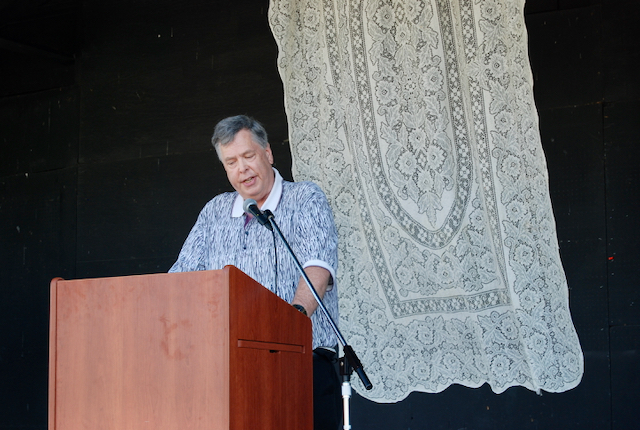
Taking the podium, Fort Atkinson resident David Stedman talked about his wife and her battle against the disease. Cheryl Stedman died in December.
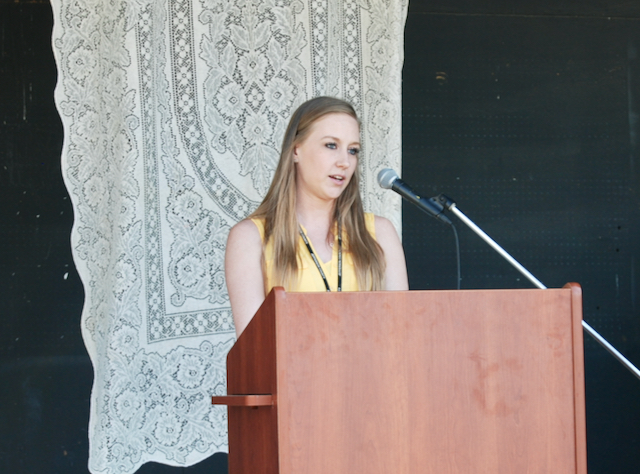
Public Health Program Manager Elizabeth Chilsen speaks about the hours of training undergone by county healthcare workers to prepare for emergencies such as the COVID-19 pandemic. Chilsen, who started working with Jefferson County in June 2019, said: “When I think about this past year-and-a-half, so many emotions start flying in.”
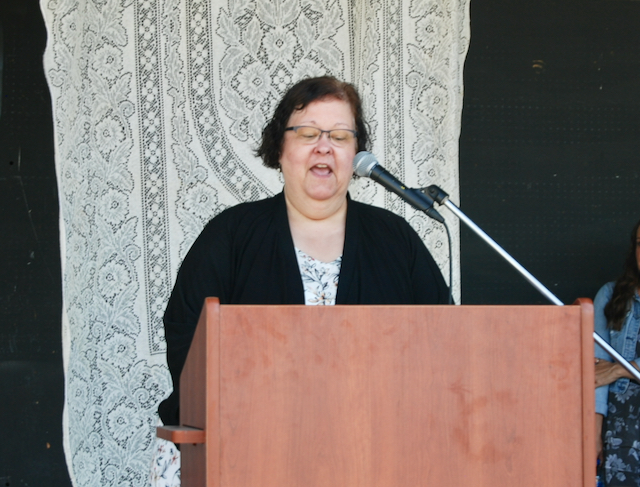
Jefferson County Health Department Director and county health officer Gail Scott calls 2020 and 2021 one of the most trying times for most public health staff.
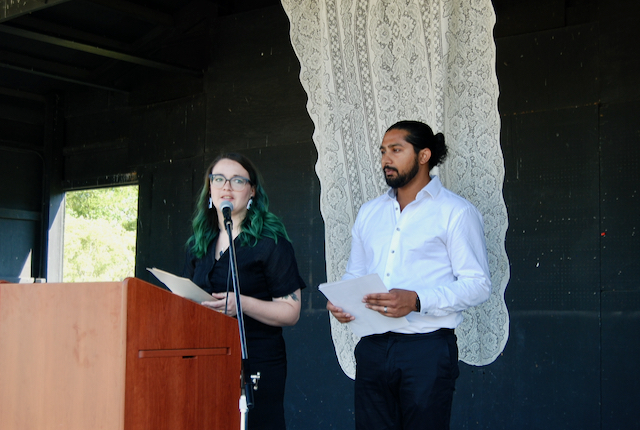
Public health nurse Keeley Johnson Crosby and county epidemiologist and COVID-19 public information officer Samroz Jakvani together salute the community. They thanked, honored and recognized those who fought to save lives and those who succumbed to the disease.
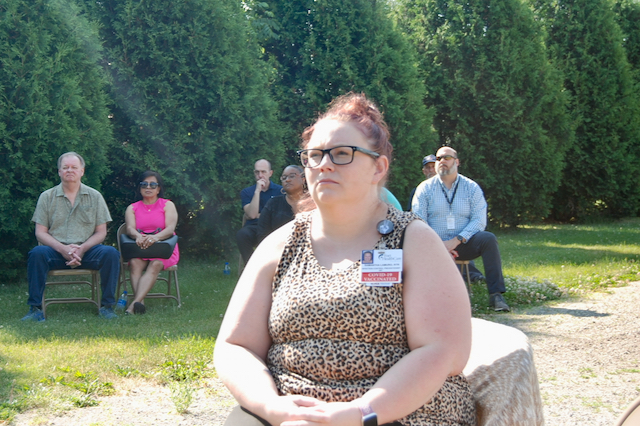
A healthcare worker listens to the program.

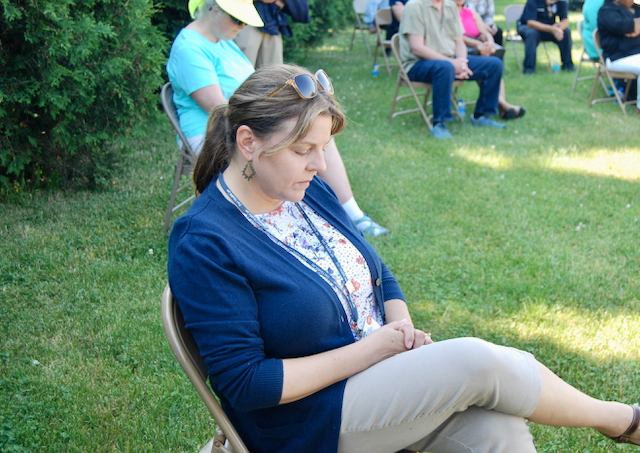
Above two photos: Program attendees observe a moment of silence.
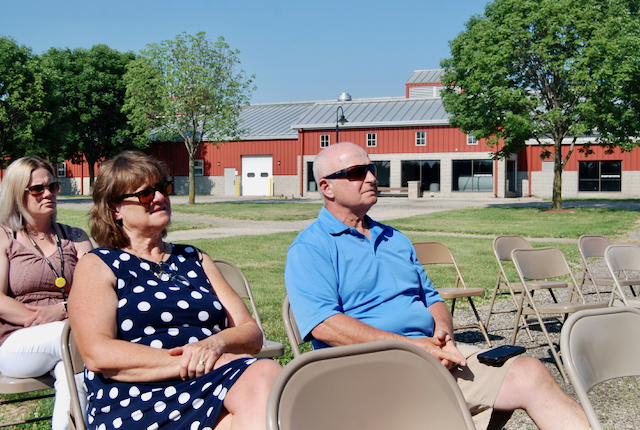
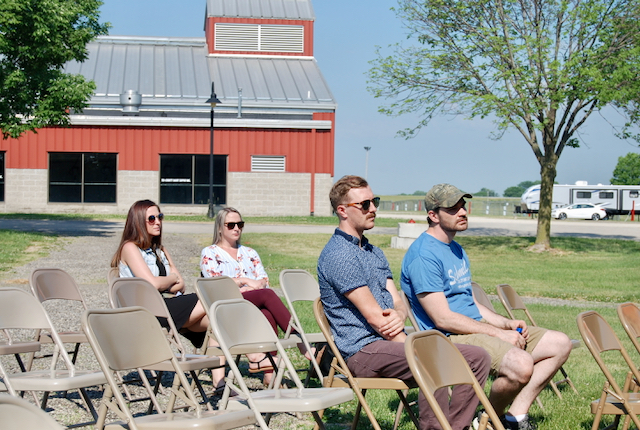
Above two photos: Attendees listen to program speakers.
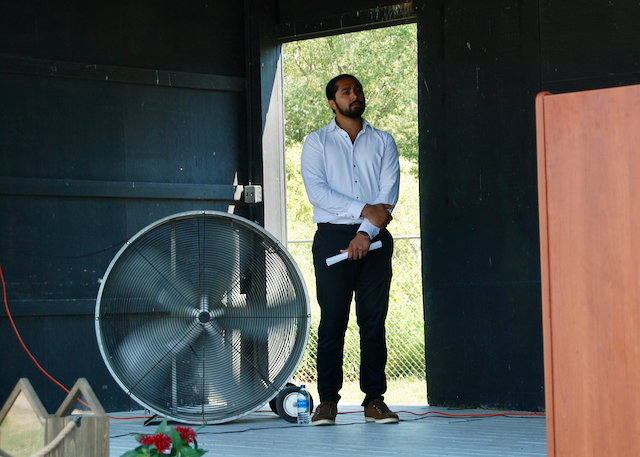
Jefferson County Health Department epidemiologist and COVID-19 public information officer Samroz Jakvani listens to fellow speakers.
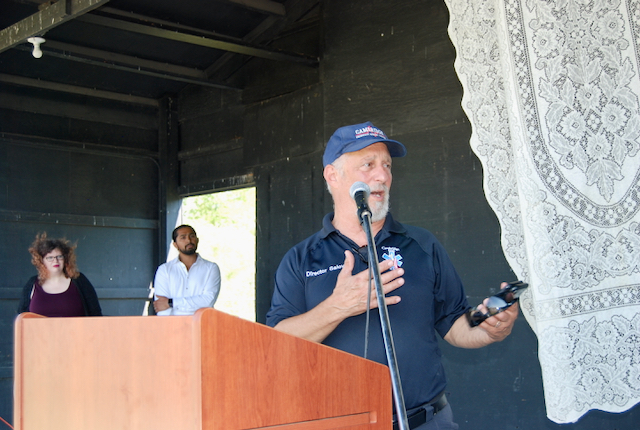
Coming from the audience to take the podium at the conclusion of the program, Bob Salov, director of the Cambridge Area Emergency Medical Service expresses his gratitude to the Jefferson County Health Department for its support. Fifty percent of his district is in the Town of Oakland area of Jefferson County, he said.
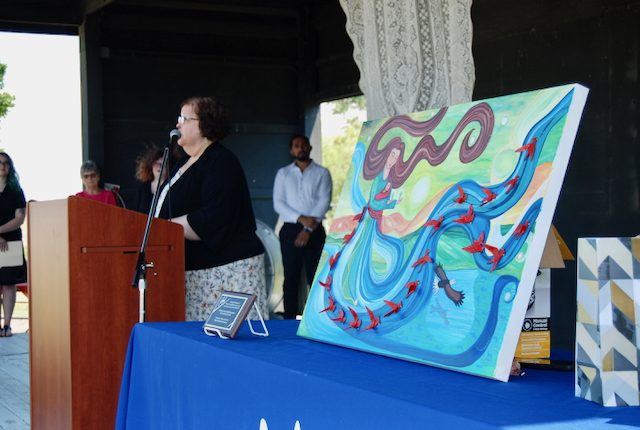
Jefferson County Public Health Department Director Gail Scott addresses the audience. She shares the stage with a painting done by artist Robin Chamberlain Sweeney. The painting was commissioned for permanent display at the Jefferson County Health Department lobby and that was formally presented at the end of the program.
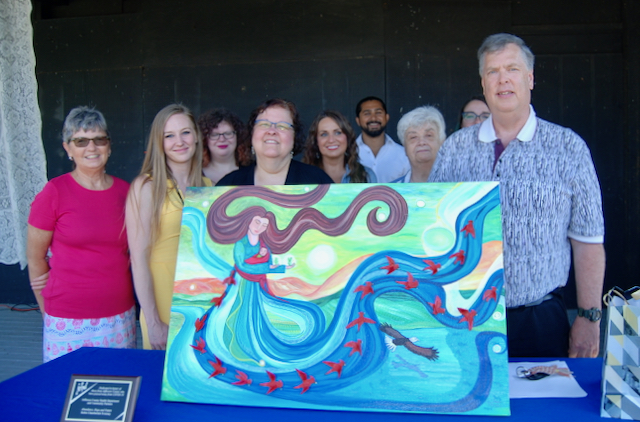
Members of the Jefferson County Health Department and program speaker and Fort Atkinson resident, David Stedman, at right, gather around art commissioned by the department symbolizing abundance, hope and the future. The piece will be on display at the Hoard Historical Museum in Fort Atkinson through July 2.
Photos by Kim McDarison.
This post has already been read 2352 times!